February Disa hikes to Silvermine, Kirstenbosch and Slangkop
by Diana Studer
- gardening for biodiversity
in Cape Town, South Africa
Gentle hike with the Ungardener's repaired knee at Silvermine. I found a blue Disa graminifolia. He could already outpace me.
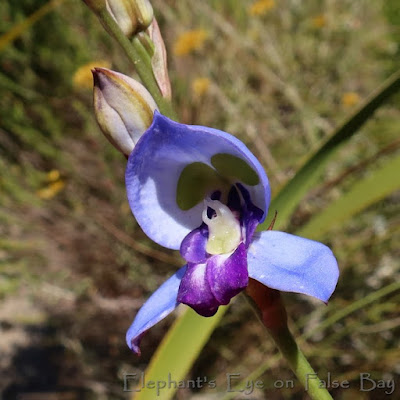 |
| Disa graminifolia |
Hiking among wildflowers
in the mountains
around Cape Town
My Fynbos Rambles to Silvermine Crags for Aspalathus crenata with pale veined leaves. Phylica dioica ivory velvet buds and dull brownish star flowers. Ursinia dentata translucent bracts and a nother yellow daisy on the upper side.
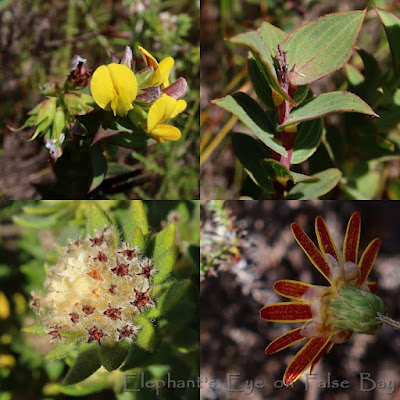 |
| February flowers on Silvermine Crags |
Kirstenbosch for red Disa uniflora Pride of Table Mountain.
 |
| Disa uniflora |
Erica nudiflora (not hairy flowers) with furry Erica hirtiflora. Mountain cypress Widdringtonia nodiflora has cones with four scales.
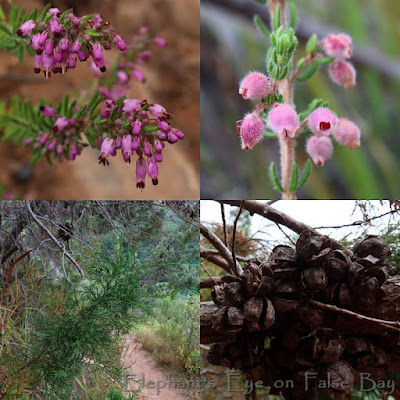 |
| Ericas and Widdringtonia |
Black, white and buttery yellow delicately marked spider. Southern blackleg orbweaver. Trichonephila fenestrata fenestrata.
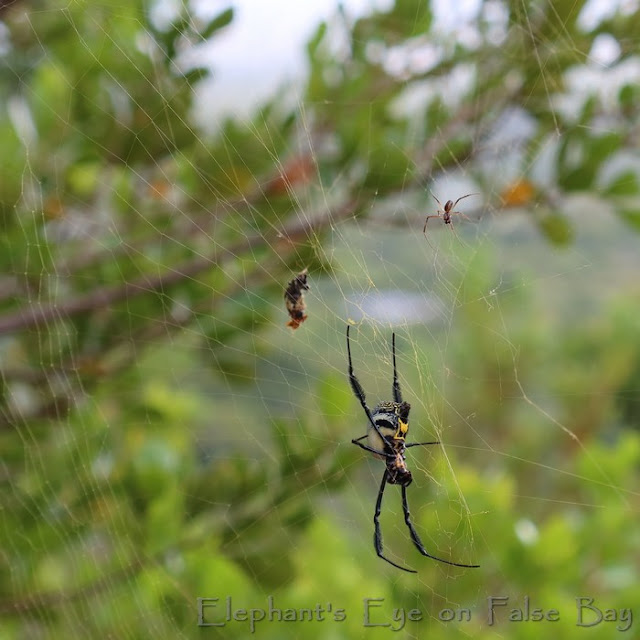 |
| Southern blackleg orbweaver |
Helichrysum nudifolium - daisy but with unexpected broad leaves. 'Culturally, medicinally, and historically, this species is one of the most important in South Africa. Leafy greens, incense and traditional medicine' - from that PZA link. Warning colours on poisonous caterpillar of Christmas butterfly eating blister bush Notobubon galbanum. Agathosma buchu.
 |
| Helichrysum caterpillar and buchu |
Slangkop to find fresh flowers after a mid-December fire. Here a reminder of how fynbos bounces back after an earlier fire, the standing dead protea bushes above the new green. Blue mountains, starting left with Hout Bay's Sentinel and Klein Leeukoppie, a corner of Table Mountain, and Chapman's Peak.
 |
| Slangkop after an earlier fire |
This we wanted to find. Haemanthus sanguineus April Fool (a little early). In all its stages from a soft coral ear emerging from white sand and dark ash, to opening flowers, and a gone to seed already. Munching caterpillar.
 |
| Haemanthus sanguineus |
Second target was Erica ferrea. So hard to find that particular pink erica, just a few bushes. Some plants recover from fire with masses of seedlings. Woody ones like protea family are often resprouters. Burnt cone and fresh green leaves of Leucadendron salignum.
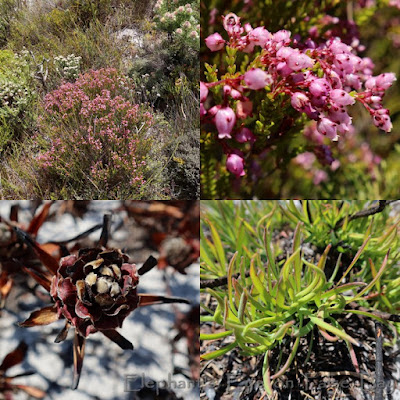 |
| Erica and Leucadendron |
Surprised to see Oftia africana covered in berries ripening to lush burgundy. The leopard graffiti has new seashore companions, a wading bird with a swimming fish.
 |
| Oftia berries |
Our hikes are listed on my page.
I invite you to join us at Elephant's Eye on False Bay. Please subscribe as you prefer
via Feedly,
or my Facebook blog page
Pictures by Diana Studer
of Elephant's Eye on False Bay
Teal blue text is my links.
To read comments if you are in a Reader,
first click thru to the blog)
Thanks for comments that add value. Your comment will not appear until I've read it. No Google account? Use Anonymous, then please include a link to your own blog. I welcome comments on posts from the last 2 months.

So good to see these beautiful flowers, Diana. Thank you!
ReplyDeleteI'm glad the Ungardener's knee is back in full operating form! As always, I love the flowers in your part of the world. The 2 Disa flowers are especially attractive to my eyes.
ReplyDeleteHis knee is getting better. March has been, interesting.
DeleteAlways so many new (to me) and stunningly beautiful plants and blooms! April Fool is a stunner. Glad you're both doing well. If I ever get to South Africa, I hope I'll be able to hike a bit and take in some of these plentiful, colorful blooms!
ReplyDeleteSo beautiful... Well, apart from the spider... I don't like those things! :D
ReplyDeleteShe was beautifully decorated.
DeleteYour plants are always so interesting especially the Haemanthus sanguineus which is remarkable! Love the spider and caterpillars, of course. :-)
ReplyDeleteVisiting your blog is always travelling for me. All these exotic plants. Wonderful!!!
ReplyDeleteAll my best dear Diana!
Have a happy happy time
Elisabeth
Dear Diana,
ReplyDeleteI am always happy when I see the magical fynbos vegetation. But I am particularly happy about the sight of Haemanthus sanguineus today - this colour, this shape, stunning!
Hugs from Austria,
Traude
https://rostrose.blogspot.com/2022/03/von-fischen-die-tomaten-dungen-von.html